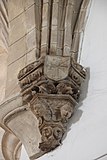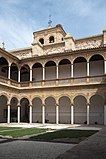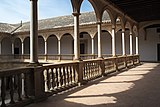Convento de la Asunción (Almagro)
The Convento de la Asunción in Almagro in the province of Ciudad Real in the Spanish Autonomous Region of Castile-La Mancha , dedicated to the Assumption of Mary , was founded in the 16th century as a convent of the Order of Calatrava . In the monastery is a two-storey cloister from the Renaissance received. The church was built in the early 16th century in the Flamboyant Gothic style. In 1931 the former monastery was declared a monument ( Bien de Interés Cultural ).
history
In 1504, the Commander of the Order of Calatrava, Gutierre de Padilla, donated a large sum of money for the construction of a hospital in Almagro. However, in 1523 the General Chapter of the Order in Burgos decided to use the money to found a convent, as it considered the care of the sick in Almagro to be sufficient. The construction of the monastery began in 1544 and the first four nuns from the Cistercian Abbey of San Clemente in Toledo came to Almagro. Because of disagreements with the superiors of the Calatrava order, however, they soon returned to their home monastery. This was followed by Cistercian women from the Las Huelgas monastery in Burgos, who stayed in Almagro until 1815. From 1827 until the abolition of all orders in 1836 in the course of the disamortization in Spain , Calatrava friars lived in the monastery. Then the monastery passed into state ownership and was used as barracks. In 1851 it was declared a Monumento Histórico and saved from ruin. Still, the buildings served as a grain store and wine cellar for fifty years. In 1903 Dominicans set up a college here and carried out various renovations.
church
The church in the Flamboyant Gothic style was the first building in the monastery to be built in the early 16th century. Its Gothic structure is already interspersed with elements of the Renaissance, as the consoles and capitals carved with heads show.
The brick bell tower rises on the north side . The coat of arms of the Dominicans, the lily cross, is emblazoned above the west portal, surrounded by the motto of the order LAUDARE BENEDICERE PRAEDICARE (Praise God, bless, proclaim). Above you can see the relief of a crowned eagle. A rosary is depicted on the left - according to legend, Dominic , the founder of the Dominican Order , received the rosary during an apparition of Mary - on the right an open book whose title SUMMA DIVI THOMAE refers to the Summa theologica of Thomas Aquinas .
The nave has a single nave and is divided into four bays . The four nave bays are covered by ribbed vaults and open into a polygonal apse in the east . Side chapels have been cut between the buttresses.
Cloister
The almost square cloister was built in the middle of the 16th century. The sandstone arcades on the two floors rest on columns made of white marble. The columns on the ground floor are decorated with Ionic capitals, the columns on the upper floor have Tuscan capitals. The upper floor is surrounded by a sandstone balustrade. Cartouches with three bread slides are attached to the arcade spandrels, the coat of arms of the Padilla family, in memory of Gutierre de Padilla, to whom the foundation of the monastery goes back. On the ground floor you can see the coat of arms alternating with rosettes .
More buildings
From the galleries of the cloister, several doors and windows with Plateresque frames open into the adjoining rooms. An artesonado ceiling has been preserved in a room on the upper floor .
The staircase has a staircase in the style of the Flamboyant Gothic.
literature
- Bernard Peugniez: Le Guide Routier de l'Europe Cistercienne . Editions du Signe, Strasbourg 2012, p. 836.
Web links
- Almagro. Monasterio de Calatravas de la Asunción Monasterios y Conventos de Castilla-La Mancha (Spanish, accessed June 14, 2016)
- Convento de la Asunción de Calatrava ciudad-almagro.com (Spanish, accessed June 14, 2016)
Coordinates: 38 ° 53 '27.5 " N , 3 ° 42' 22.7" W.













